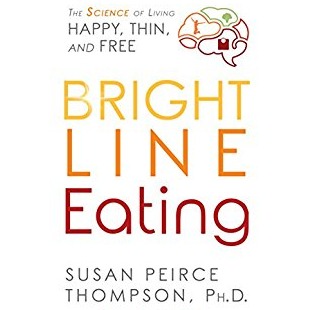 I believe in science. When I was offered the opportunity to check out Dr. Susan Peirce Thompson’s new book Bright Line Eating: The Science of Living Happy, Thin and Free, I was intrigued.
I believe in science. When I was offered the opportunity to check out Dr. Susan Peirce Thompson’s new book Bright Line Eating: The Science of Living Happy, Thin and Free, I was intrigued.
Peirce Thompson is a PhD in Brain and Cognitive Sciences and an expert in the psychology of eating. She is President of the Institute for Sustainable Weight Loss and CEO of Bright Line Eating Solutions, a company dedicated to “sharing the psychology and neuroscience of sustainable weight loss.”
Susan’s personal story is interesting, too. A former drug addict, she was amazed to discover in her research that consuming sugar and flour actually changes the brain. It “rewires” it to make us continue returning to sugar and flour again and again. Basically, she found that sugar and flour are addictive. I believe that about sugar and am not surprised about flour, but I haven’t heard that specifically.
After learning the concept of “bright lines” from Roy Baumeister’s book Willpower, she developed “bright lines” for eating. The term “bright line” rule is normally used in a legal context. Wikipedia defines a bright line rule as “a clearly defined rule or standard, composed of objective factors, which leaves little or no room for varying interpretation. The purpose of a bright-line rule is to produce predictable and consistent results in its application.” Baumeister thought you could have bright lines for alcohol or drugs, but not food, because everyone needs to eat. Susan disagreed and created her program.
They offer a “Food Freedom” quiz to see how susceptible you are to overeating and food addiction. You can take it here. I “aced” this test… and not in a good way. I was very excited to check out this plan.

Bright Line Eating has three “bright lines.” They are no sugar (added or artificial sweeteners and no alcohol), no flour (of any kind) and meals only (no snacks.) It is intended for weight loss initially and then to be used forever. The concept is that it helps you to kick sugar/flour addiction and then to take away the hold that food has on your life by removing the multitude of food decisions available to you each day. The “bright lines” take away the massive food “gray” area.
I’ll be honest with you. I was really busy and didn’t look into the plan before receiving the book. This plan is very restrictive and not meant for people who exercise and travel a great deal like me. It’s also intended for weight loss (though some people use it for other reasons). While I do have 5 – 10 lbs to shake, I am not in a position to commit to this restrictive of a plan. I did enjoy reading the science and psychology of food addiction and willpower. It’s pretty fascinating.
Are you interested in Bright Line Eating? I have 2 copies of the book to share. To enter, please leave a comment on what interests you about this book or take the Food Freedom Quiz and share how you did and whether that was what you expected. Want an extra entry? Follow Bright Line Eating on Facebook and leave a separate comment to tell me that you did. Giveaway runs through March 29th. Two winners will be selected with random.org in order of comment and notified on March 30th. Winners must be 18 years of age or older, in the US and the contest is void where prohibited.
Want to try Bright Line Eating? Right now, you can sign up for the 14 Day challenge and get a free hard cover book for only $29. Click the link in the tweet.
#FeelGood in your body! #FeelAmazing in your skin. Try the #14DayChallenge & get a FREE hardback book+FREE shipping!https://t.co/pUuJJczpa5 pic.twitter.com/5RfLxoMwft
— Susan PeirceThompson (@DrSPThompson) February 1, 2017
Would Bright Line Eating work with your lifestyle? Do you believe that sugar and flour are addictive? I’d love to hear your thoughts in the comments.
Please note: I received a copy of the book at no cost in exchange for editorial consideration. I was not otherwise compensated for this post. All opinions are my own. The post contains an Amazon affiliate link. If you use this link, I will receive a small commission.
If you’re interested, I have some FAQs on willpower to share from the author.
Q. How would you define willpower in the context of the brain and its cues/responses?
A. Many people mistakenly think willpower is a function of character and tell people trying to lose weight, “You just need to have more willpower.” That’s not how it works. Willpower is a cognitive function and we all have about the same amount of it to draw from–fifteen minutes. And it’s the same supply we’re drawing from to focus at work, pay attention to our boss, and keep our patience with our children. It is no wonder so many parents go straight from tucking their kids in at night to the kitchen. Or employees go right from a stressful meeting where they managed to hold their tongue–into the break room looking for cookies. The key to a successful diet is it MUST expect that your willpower will be fully depleted at least once a day–and work anyway.
Q. What are ways to sustain good choices when willpower dissolves?
A. The key, first, is that you MUST expect your willpower to become fully depleted at least once a day, and be prepared for the likely scenario that you manage not to lose your patience with your kids — and then order the Cinnebon. Or, at a family meal, you manage not to hold your temper with your mother, then go for a third helping of pie.
Once you know that you should fully expect your willpower to get zapped, especially in stressful situations, like the monthly meeting at work where they always have donut holes on the conference table, you can decide AHEAD OF TIME exactly what you will and won’t put in your mouth–and stick to it. Then you can just fall back on your prior commitment and keep the chattering part of your brain quiet. The part telling you you just made it through listening to your boss impersonate Britney Spears and you deserve a cookie.”
Q. How does an ‘attitude of gratitude’ help sustain willpower?
A. Research shows that gratitude is one of five scientifically-proven behaviors that, in the moment, will replenish willpower and help us to triumph over temptation. (The others are social support, prayer, meditation, and service.) Hence, practicing an “attitude of gratitude” is one of the best ways to harness the brain’s ability to resist unwanted and unneeded extra food. It also shifts your attention from what you want, to what you already have.
Q. Can someone ‘build’ willpower or is it sort of in limited supply?
A. There are a few behaviors that build willpower–sleep, gratitude, prayer, and stress reduction. Stress reduction may sound laughable to many people, but stress management is possible — anticipating stressful situations and deciding on strategies for keeping them short if possible, or for reducing their stress. And everyone can take a moment to close their eyes and quickly think of five things they are grateful for. Just that simple action can replenish willpower.


